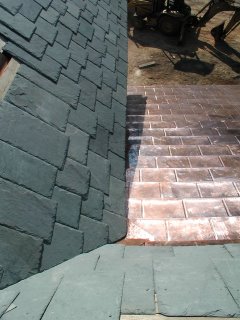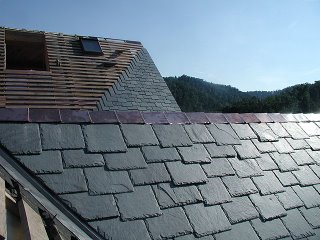Copper shingles are on!

 We finished the copper shingles today. They
We finished the copper shingles today. Theyturned out great. I guess the main advantage of copper shingles over standing seam copper is that a home owner without special tools (you'll need a hammer, metal shears and some wide pliers) can apply them. Standing seam copper might be more weather resistant, but these shingles look like they'll do a good job. Before I chose these copper shingles, I ordered samples of them from Paradigm Shingles and from Zappone. These looked like a better shingle (sturdier and more weather resistant) to me.
 Here's an example of a closed valley with step flashing that we started on today. I've found two reasons to like stepped flashing better than continuous flashing - #1. when water goes beneath the slate and hits the step flashing, it will come back out on top of the slate in the next course. Whereas with continuous flashing, any water (and dirt and pollen) that goes under the slate remains under the slate until it reaches the end of the valley. #2. when you install stepped flashing, you can nail right through the flashing when you install the slate above it. Better not try that with continuous flashing! In fact, you often have to punch holes in valley slates in order to avoid nailing through continuous flashing... making a tedious job even more tedious.
Here's an example of a closed valley with step flashing that we started on today. I've found two reasons to like stepped flashing better than continuous flashing - #1. when water goes beneath the slate and hits the step flashing, it will come back out on top of the slate in the next course. Whereas with continuous flashing, any water (and dirt and pollen) that goes under the slate remains under the slate until it reaches the end of the valley. #2. when you install stepped flashing, you can nail right through the flashing when you install the slate above it. Better not try that with continuous flashing! In fact, you often have to punch holes in valley slates in order to avoid nailing through continuous flashing... making a tedious job even more tedious.
Don't really have much to say about this last picture other than... why would you ever use fake slate, when the real stuff looks like this and is proven to last over 100 years?


0 Comments:
Post a Comment
<< Home